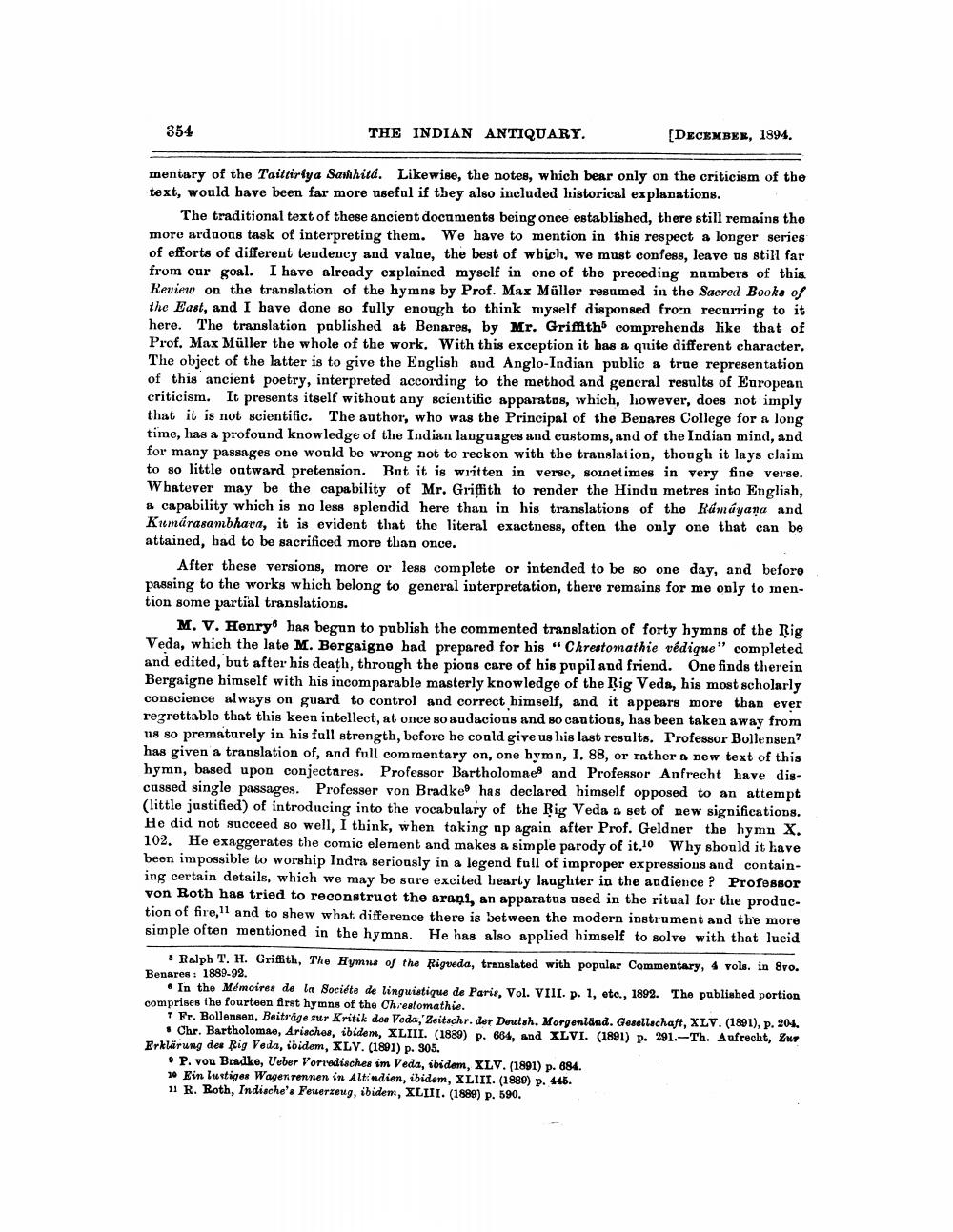________________
354
THE INDIAN ANTIQUARY.
[DECEMBEE, 1894.
mentary of the Taittiriya Sanhita. Likewise, the notes, which bear only on the criticism of the text, would have been far more useful if they also included historical explanations.
The traditional text of these ancient documents being once established, there still remains the more arduous task of interpreting them. We have to mention in this respect a longer series of efforts of different tendency and value, the best of which, we must confess, leave us still far from our goal. I have already explained myself in one of the preceding numbers of this. Review on the translation of the hymns by Prof. Max Mäller resumed in the Sacred Books of the East, and I have done so fully enough to think myself disponsed fron recurring to it here. The translation pablished at Benares, by Mr. Griffith comprehends like that of Prof. Max Müller the whole of the work. With this exception it has a qnite different character. The object of the latter is to give the English and Anglo-Indian public a true representation of this ancient poetry, interpreted according to the method and general results of European criticism. It presents itself without any scientific apparatas, which, however, does not imply that it is not scientific. The author, who was the Principal of the Bepares College for a long time, has a profound knowledge of the Indian languages and customs, and of the Indian mind, and for many passages one would be wrong not to reckon with the translation, though it lays claim to so little outward pretension. But it is written in verse, sometimes in very fine verse. Whatever may be the capability of Mr. Griffith to render the Hindu metres into English, & capability which is no less splendid here than in his translations of the Rámáyana and Kumarasambhava, it is evident that the literal exactness, often the only one that can be attained, had to be sacrificed more than once.
After these versions, more or less complete or intended to be so one day, and before passing to the works which belong to general interpretation, there remains for me only to mention some partial translations.
M. V. Henry has begun to publish the commented translation of forty hymns of the Rig Veda, which the late M. Bergaigne had prepared for his “ Chrestomathie védique" completed and edited, but after his death, through the pions care of his pupil and friend. One finds therein Bergaigne himself with his incomparable masterly knowledge of the Rig Veda, his most scholarly conscience always on guard to control and correct himself, and it appears more than ever regrettable that this keen intellect, at once so audacions and so cautions, has been taken away from us so prematurely in his full strength, before he could give us lis last results. Professor Bollensen? has given a translation of, and full commentary on, one hymn, 1. 88, or rather a new text of this hymn, based upon conjectares. Professor Bartholomae and Professor Aufrecht have discussed single passages. Professer von Bradke has declared himself opposed to an attempt (little justified) of introducing into the vocabulary of the Rig Veda a set of new significations. He did not succeed so well, I think, when taking up again after Prof. Geldner the hymn X. 102. He exaggerates the comic element and makes a simple parody of it.1o Why should it have been impossible to worship Indra seriously in a legend full of improper expressions and containing certain details, which we may be sure excited hearty laughter in the audience P Professor von Roth has tried to reconstruct the arani, an apparatus used in the ritual for the production of fire, 11 and to shew what difference there is between the modern instrument and the more simple often mentioned in the hymns. He has also applied himself to solve with that lucid
Ralph T. H. Griffith, The Hymns of the Rigveda, translated with popular Commentary, 4 vols. in 8vo. Benares: 1889-92.
• In the Mémoires de la Sociéte de linguistique de Paris, Vol. VIII. p. 1, etc., 1892. The published portion comprises the fourteen first hymns of the Chrestomathie.
T Fr. Bollensen, Beiträge zur Kritik der Veda,' Zeitschr. der Deutsh. Morgenland. Gesellschaft, XLV. (1891), p. 204.
. Chr. Bartholomae, Ariaches, ibidem, XLIII. (1889) p. 664, and XLVI. (1891) p. 291.-Th. Aufrecht, Zwr Erklärung des Rig Veda, ibidem, XLV. (1891) p. 305.
. P. von Bradke, Veber Vorredisches im Veda, ibidem, XLV. (1891) p. 884. 10 Ein lustiges Wagen rennen in Altindion, ibidem, XLIII. (1889) p. 445. 11 R. Roth, Indische'. Feuerzeug, ibidem, XLIII. (1889) p. 590.




